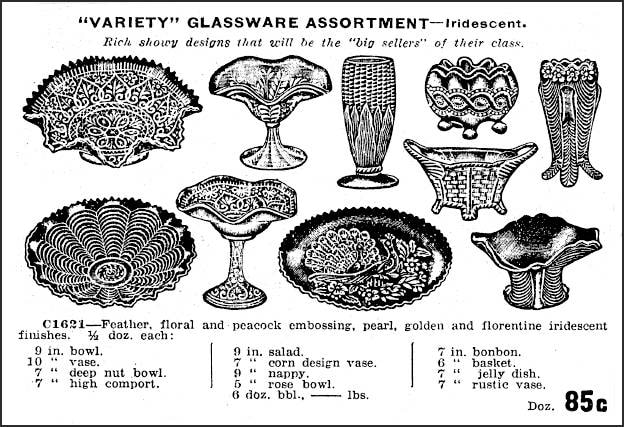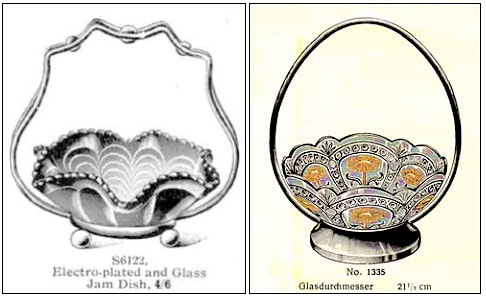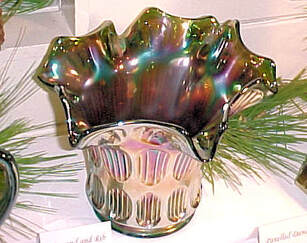NetworK ezine Issue 48. May 2019
Totally Devoted to Carnival Glass
Baskets for May – How to Handle them!
|
May is the perfect time for flower baskets – they were produced by the Classic USA and European Carnival makers, and are always popular with collectors. Northwood’s Bushel Basket is a perfect example and a constant favourite – known in a wide variety of Carnival colours, in both the round and 8-sided version (shown below).
Purple 8-sided Northwood Bushel Basket.
Courtesy Seeck Auctions. |
Perfect for Springtime – the Bushel Basket was among this Butler Bros. wholesale ad
for Northwood’s "Variety" Assortment, April 1912. |
The marigold basket on the right is often simply called the May Basket, despite there being several different, moulded designs on these pretty pieces. This one has a Maple Leaf design, while others feature Fleur de Lys and other patterns. These baskets were made in England at Matthew Turnbull’s glass works. Possibly the most fascinating Carnival example is the scarce Royal commemorative, George VI Basket.
All the known Turnbull May Baskets patterns are here: Matthew Turnbull.
All the known Turnbull May Baskets patterns are here: Matthew Turnbull.
|
The Turnbull baskets were made with glass handles, which were actually moulded in the piece. In other cases, handles were sometimes applied separately by a skilled glassworker called a “handler”. But there are also some examples of Carnival that were mounted in metalware. These “partnerships” or “pairings” were effected post-production, usually by the wholesalers or retailers. On the right is a Northwood Three Fruits plate turned into an “Iridescent Glass Cake Basket” with a “silvered wire handle”. |
The wonderful image above was shown in the Lee Manufacturing 1911 catalogue of premiums, shown courtesy of Lance Hilkene. Note that the ad explained that the “twisted silvered metal wire handle … can be taken off or left on at your pleasure”. Note also that the glass was described as “Egyptian Art” – a perfect example of a promotional hype term with no basis in fact (the glass was of course, made in the USA by Northwood).
|
|
On the right are two more glass baskets mounted in handled metalware. On the immediate right: an amazing item that appeared in a 1910 catalogue for the British pharmacy store called "Boots, The Chemist". It is definitely a Fenton Peacock Tail berry (you can see the Wide Panel exterior) sat in a holder that turned it into a “jam dish”. The holder is "EPNS" (electro-plated nickel silver). We have seen other Carnival berry dishes in holders like this, including Fenton’s Vintage (Grape) items. So, a piece of American Carnival is married up with British metal ware. On the far right: from Germany, a Brockwitz Asters bowl is shown in a nickel zinc holder. The metal holder was one of many produced by Merkl for Brockwitz glass. The image is from a c.1925-1930 Metallwarenfabrik Stefan Merkl catalogue, courtesy Siegmar Geiselberger. |
|
One Mould - Many Shapes
Glass is, of course, very hot as it emerges from the mould – because of this fact, it can be shaped, swung and altered, as it is still malleable. The skills of the glass makers, coupled with a range of tools and formers, gave rise to many variations and varieties of form as they shaped the hot glass. Bowls were often ruffled and crimped. Some tall vases started as relatively short items in the mould, but were then swung by the glassmaker to form taller vases. A very dramatic example is provided by the contrast between a Fenton Diamond and Rib funeral vase and a Diamond and Rib jardiniere. - as shown on the right. The jardinière was unswung - it was exactly as it came from the mould, whereas the funeral vase was swung into this elongated shape while hot, after removal from the mould. Above: this rare Diamond and Rib jardiniere
was shaped further by ruffling around the top. |
We have a wonderful video as part of our "Howard Seufer Presents ..." series. In it, Howard and Frank Fenton discuss vases – big, small, swung and “as pressed” – with a selection of pieces that will take your breath away. Here is the link (the video on vases is Video #3): Howard Seufer Presents ... |
|
Sheraton
Hands up if you have ever heard of Reuben Haley. No one? Anyone? We admit that it wasn’t a name that we immediately recognised, and yet he had an important impact on the development of pressed glass design. He produced designs for Westmoreland, Fostoria and United States Glass, one of which was a notable 1912 introduction for U.S. Glass, called “Sheraton”. So how is that connected with Carnival … Hands up again if you knew that the “Sheraton” pattern was made in Carnival Glass. If you are a member of our Carnival Glass Network Group, then the answer may well be a resounding “yes”. In early May, Greg Dilian reported this handled sugar in the Sheraton pattern, and he surprised us all by disclosing an amazing secret connected to the glass. It has a United States Glass moulded trademark on it. Read the fascinating story behind this amazing piece of glass that was shown to us by Greg, and find out how it got its name, see the original patent design as well as many old 1913 ads and archive evidence. Here is the link: Sheraton by U S Glass Co. |
Sheraton handled sugar, courtesy of Greg Dilian.
|
|
Pioneer Glass
In the April issue of NetworK we featured a fascinating Lions Foot creamer that led us on a trail to discover more about the establishment of the “Save Imperial Committee” in 1984. The Story Behind the Glass is here: Lions Foot. Thanks to further information courtesy of Mitchell Stewart, we now know the names of the workers who worked at Pioneer Glass in Bellaire, using mainly old Imperial moulds - in fact, 90% of Pioneer’s moulds were Imperial’s. Bob Simsa (ex-Fostoria), Harold Logsdon, Brad Law and Willard Kolb are the names recorded for posterity in various documents. It appears that the very first glass item they made was “an orange bird”, and of course, we also know that Pioneer's production included Contemporary Carnival Glass. From our research and other documents, we have put together the story of Pioneer Glass, and added it to our website. Courtesy of Mitchell Stewart, it includes three pages of a booklet that shows photos of their production process. Here's the link: Pioneer Glass. |
A clip from the Pioneer article, courtesy Mitchell Stewart.
|
|
Sunburst Yellow Carnival Glass
|
Sunburst Yellow Carnival was the name of the yellow iridescent colour given by the Arthur Lorch (ALIG - the successor to Imperial Glass) in their 1982-1983 sales period. It was described evocatively as having “sun sparkled hues” and indeed, it is a delightful, pastel shade that is very delicate and pretty. The items were said to be trademarked with ALIG (though sometimes IG may be found) and it may often take a bit of searching to locate the trademark. The Gothic Arches vase pictured here (#42735) was simply called 10" - 14" Swung Vase in the catalogue - it has the mark on the inside of the base! We have shown two full pages of Sunburst Yellow Carnival in large size on our website, for you to study. There are almost 30 items. Here is the link: ALIG Sunburst Yellow. |
|
Grape and Cable – our latest FREE eBook! A question that crops up frequently in our Carnival Glass NetworK Group on Facebook is how to distinguish between the Northwood and Fenton versions of Grape and Cable. To help all collectors, we’ve created a fully illustrated, ten-page FREE eBook that is now available to download as a pdf from our website. There’s lots more information too, including more on Grape and Cable fakes. We hope you will enjoy it. Here’s the link to the download page: Free Carnival Glass eBooks |
Privacy and the use of your information: we only use your name and email address to send you your FREE Carnival Glass NetworK ezine. We will not share your name or email address with anyone else, or use it for any other purpose. You can change your mind about receiving your NetworK ezine at any time by clicking the unsubscribe link at the foot of every issue, or by emailing us at [email protected]
Join us on Facebook
We invite you and your friends to join us all on NetworK's fast growing and very active Facebook Group (link is below), and if you have missed any of the previous issues of NetworK and NetworK Specials, they are all here: Back Issues.
We invite you and your friends to join us all on NetworK's fast growing and very active Facebook Group (link is below), and if you have missed any of the previous issues of NetworK and NetworK Specials, they are all here: Back Issues.













